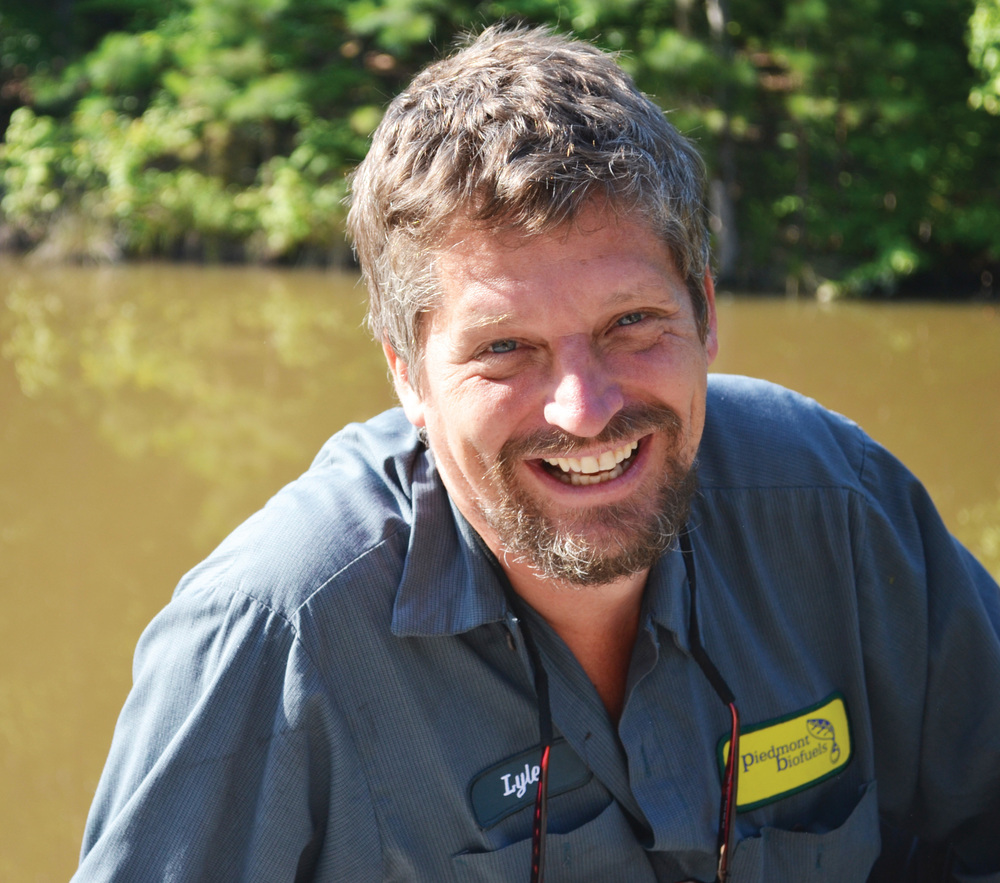Safety From the School of Hard Knocks

October 28, 2013
BY Lyle Estill
At Piedmont Biofuels we came by our culture of safety the hard way. We’ve been making biodiesel since 2002 and we have lots of “thrills, chills and excitement” to show for it.
When we were brewing up fuel in the backyard, we put our first “safety policy” in place. That was, drinks were limited to one part of the shop, and not allowed near the methanol or isopropyl. That was fortunate for Leif and me. When our 55-gallon reactor blew up, we were having coffee around the corner. Janice said it shook her windows a half-mile away.
When we went to work on our commercial plant (1 MMgy) in 2005, we became a massive construction zone—lots of welding, rigging and dangerous work to be done. Matt sliced his hand with a carpet knife and experienced some serious blood loss. Sparks from an oxy-fuel cutting rig penetrated a hydraulic line on the crane we were using. That was our our first fire. Dean put that one out with a nearby fire extinguisher. We had another fire on our box truck when one of our interns decided to drive across the state with the parking brake on. With no extinguisher on board, we lost that vehicle. Our third fire occurred when Chris was rebuilding a fouled boiler. Without proper lockout/tagout procedures in place, the boiler room was re-energized while we were at lunch together. David put that one out with a fire extinguisher.
Advertisement
Advertisement
The real danger began when the plant started operating—and we remained under construction. It seemed like we were constantly modifying, expanding or correcting our homemade plant, and we were doing it in the context of production. Our first serious accident occurred when Ponytail and Rick were blown off the top of a three-story feedstock tank they were welding on. Unbeknownst to them, one of our production guys had used some methanol-laden bottoms to strip a load of high-FFA feedstock in that tank. With one guy in the burn unit and another in ICU, a sense of terror and dread settled over our project. They both survived, and have remained friends of our project, but that accident sent us squarely into “OSHA mode.”
We started documenting like crazy. We started standard operating procedures (SOPs) everywhere while we watched our worker’s compensation payments travel skyward. It didn’t help when Joe fell into a one-story concrete pit next to our reactor room and was seriously injured. One thing his accident inspired was “day lighting.” We started putting in Plexiglas sheets and doors with windows wherever possible so we had no spaces that were pitch black without lights on. And we moved on brightly painted rails. And on conformance.
Advertisement
Advertisement
We started behaving the way a chemical plant should behave. Although we are no longer OSHA-obligated, we still act as if we are—maintaining a safety committee, with quarterly walk-throughs and documentation of problem areas we identify at the plant. Safety became a regular item at our Monday morning staff meeting, as did plant cleanliness, since the two are inextricably mixed. We document minor injuries in order to learn from them. That might come from Paul handling toxic cashew oil sent to our lab for characterization, causing an extreme dermatitis reaction that would make anyone beg for poison ivy. Or from a bad lift that injured Spencer’s back. Also on the log is the time I was swatted from the building while cutting a 12,000-gallon poly tank that was filled with deadly embodied energy.
Our most famous fire occurred in the spring of 2013, when our SOP for filter-aid handling was not followed. A tray of biodiesel-ensconced filter media spontaneously combusted in the dead of the night. It turned our wash-dry facility into a four-story oven. We lost our filter press and a bunch of other stuff that we probably should have purged years ago. The fire gave us an opportunity to rewire our 30-year-old building—and to simplify operations there—but it was a significant financial setback and a truly expensive lesson to learn. Again.
Nowadays our plant is spinning like a top. Every drop of fuel is spoken for before it is even made, and we have a tight-knit crew. I would say Piedmont Biofuels might be the poster child for learning things the hard way. But we have survived the journey. We are resilient. And we are safely and happily making and distributing our BQ-9000 fuel to the motoring public.
Author: Lyle Estill
President, Piedmont Biofuels
919-321-8260
lyle@biofuels.coop
Related Stories
The U.S. Energy Information Administration maintained its forecast for 2025 and 2026 biodiesel, renewable diesel and sustainable aviation fuel (SAF) production in its latest Short-Term Energy Outlook, released July 8.
XCF Global Inc. on July 10 shared its strategic plan to invest close to $1 billion in developing a network of SAF production facilities, expanding its U.S. footprint, and advancing its international growth strategy.
U.S. fuel ethanol capacity fell slightly in April, while biodiesel and renewable diesel capacity held steady, according to data released by the U.S. EIA on June 30. Feedstock consumption was down when compared to the previous month.
XCF Global Inc. on July 8 provided a production update on its flagship New Rise Reno facility, underscoring that the plant has successfully produced SAF, renewable diesel, and renewable naphtha during its initial ramp-up.
The USDA’s Risk Management Agency is implementing multiple changes to the Camelina pilot insurance program for the 2026 and succeeding crop years. The changes will expand coverage options and provide greater flexibility for producers.
Upcoming Events










